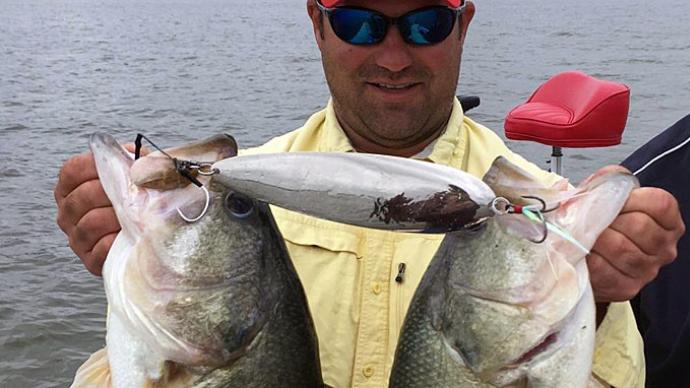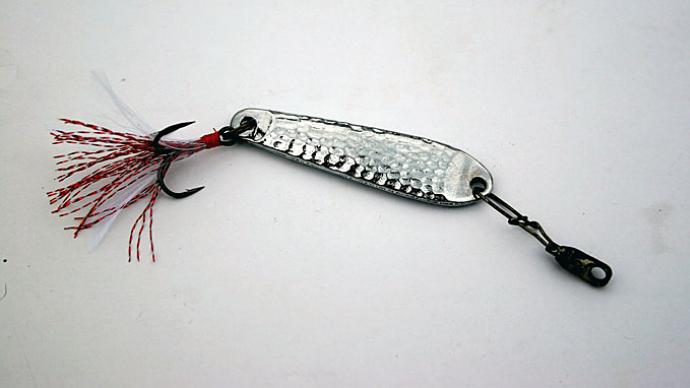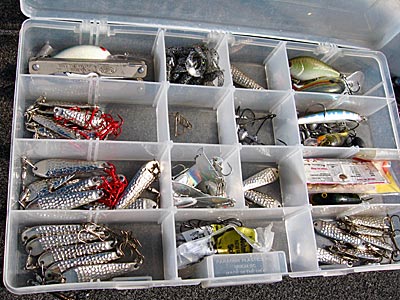
You might not think of spoons as summer baits, but they are excellent for this time of year. I’ve heard many fishermen compare summer to winter (and spring to fall) because the bass tend to behave similarly, which means that a good winter bait should be a good summer bait and vice versa. Spoons are like that. I know guys who fish spoons all year long, and you might be surprised at some places where you can work a spoon. It all depends on what type of spoon you choose and how you rig it. So here are five places to fish spoons in summer, some of which may surprise you.
Weeds
That’s right – pick the right spoon, and you can work it through the weeds, even the thick grasses of summer. Nemire Lures has a variety of spoons and lures made from spoons that you should check out. Their cupped spoons have rattles built right in – crossways, so when that spoon wobbles, it also rattles. They are built for fishing in vegetation, with a weed guard built right in – they are designed to come through the cover. These wobbly spoons have a lot of flash, and because they sink, you can cast them to shore and work them back through the grass, lily pads, or whatever kind of nasty stuff you’re facing. They come with a trailer, and you can dress them up with a different trailer – like a Yamamoto grub or even a little fluke. This means that you can also add scent to them.
There are plenty of other weedless spoons out there as well. Bagley makes them, and so do plenty of other manufacturers (think Johnson Silver Minnow). Look for something with a sturdy weed guard, but not so sturdy that it makes it tough to set the hook. Braid is a good idea for weed fishing because it helps cut through the weeds. It also makes it easier to set the hook and haul the fish out of the thick stuff.
Fishing a spoon over the weeds is another option, and Nemire has a Buzz Ripper lure that is a spoon with a buzzbait blade attached. It still has that rattle, and the rounded front end of the bait helps it glide through any surface weeds. The buzzbait blade, the wobble, the rattle, and the flash make it easy for a bass to hone in on even in the thick stuff. Try cranking this over the mat and letting it drop into the pocket, and hang on! Nemire’s Spin Ripper is a spoon with a spinnerbait blade attached. Nemire Lure’s R & D guy, Al Fisher, says that the spoon body pushes the grass out of the way so it doesn’t hang up on the blade. It’s like a sled, and it comes through cover like a charm.
Bluffs
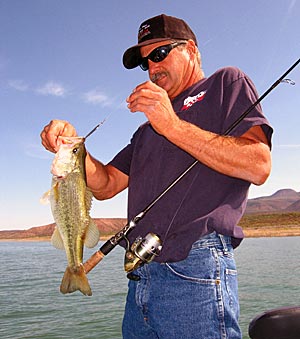
I love fishing bluffs almost every time because they provide cover and structure. No matter how deep the bass are, you can find them on bluffs. A spoon is ideal for bluffs because when it flutters down, it looks like a dying minnow. Steve Foutch, an Arizona angler, switches to a heavier spoon when he’s fishing vertical structure. He casts it out parallel to the wall, lets it fall, and then rips it back like a jerk bait. He throws his spoons on spinning gear. A spoon falls quickly – about a foot a second – so he counts it down until it is close to the bottom, then begins his retrieve. If you watch him, he closes the bail, and then before he rips it, he shoves the rod forward about a foot. Then he rips it up almost straight over his head, takes up the slack, then rips it again.
The fish often take the bait on the fall, during that little pause, he lowers the rod and shoves it forward before swinging up on it again. Sunshine plays a big part in how well a spoon works. Sunlight is what gives a spoon its flash, so in the very early morning or on a very cloudy day, another lure might work better. But a spoon is hard to beat on a bright day in relatively clear water. If the fish are finicky and you need to downsize, try a tungsten spoon like the ones made by Northland Fishing Tackle. These are 30 percent heavier by size than regular spoons, so you can downsize but still get them down quickly – a real plus for those deep-water summer bass. These Tungsten Silver Spoons (and yes, it’s spelled “Sliver”) also have a KickerTail® fin at the end that adds a lot of action whether you’re dropping it or swimming it.
Along the same lines as a bluff are things like pilings and piers. You can pitch a spoon to these vertical structures – the speed and flash will often make a bass commit quickly before it gets away from him.
Channels
You might only think of those major river and creek channels when you think of “channel,” but in the summer, you can find a lot of fish in tiny channels on flats. Look at the shoreline. Any crease you see in the land most likely continues into the water, and bass uses those creases like a highway. Even a crease as shallow as two or three feet can hold a lot of fish. The best spoons for these little cuts are the swimming spoons – the cupped ones like Silver Minnows and Red Rippers. Spoons come in so many finishes now that you can match just about any baitfish in the lake. Choose a size that flutters slowly, especially if you are fishing shallowly. Just cast it to shore and crank it back, pumping the rod as you reel to give the bait some lift and fall. You’ll either have to crank quickly or use a very light spoon, or you’ll end up on the bottom-most of the time. Pay attention to any rocks or stumps near the channel, and try to get close as you pass by.
Of course, those big deep channels are also great places to find bass in summer, and you can certainly swim a spoon down a channel with fantastic results, but it’s often easier to jig a spoon up and down in a big deep channel the same way you’d fish a bluff.
Trees
You can fish spoons in submerged trees – you need to make a few adjustments. Bass love to hang out in the center of submerged trees, which can be the hardest place to get to them. Even a worm with heavy weight has a hard time getting through. The worm tends to hang up on the wet wood or separate from the weight and ends up almost tied to a branch. But an excellent heavy spoon will drop right down between all those branches and flutter right past that big bass hiding in the wood.
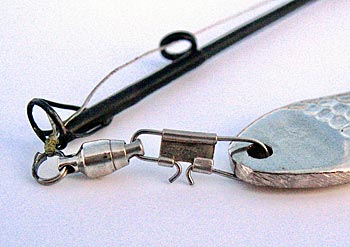
To keep from constant snagging, use a single hook. If even a single hook is snagging, try flattening the barb or switching to a hook with a more circular bend. Also, use a heavy slab-like spoon that will fall right over and through everything. If you feel stuck, rip that bad boy – it could be a fish – then don’t reel it back in immediately. Let it flutter down after you rip it; you might get bit. That happens a lot. Out here in the west, there are trees aptly named Ironwood trees that are stronger than horseradish. Even decades after being submerged, they still have branches. When the water falls, you can find all kinds of lures dangling from those branches, but I’ve yet to see a big spoon among them. You might want to switch to a sturdy mono or fluorocarbon fishing these deep trees if your braid gets hung up too much. When braid gets soaked, it does tend to hold on to stuff.
Flats
Bass are usually on flats for one reason – they are looking for something to eat. There are many ways to fish a flat, but a swimming spoon is fantastic for several reasons: the flash, the wobble, and the speed. Also, bass doesn’t see many spoons on flats, so they probably won’t be wary of them. Fish them here by simply casting to shore and cranking them back. You can sort of count them down to keep them at a certain depth or pump them back as you do on vertical structure and channels. Flats are necessarily shallow, so a spoon is ideal for those deeper flats where the bass chase shad. Adding a trailer can slow the fall if you need to fish it slowly.
A spoon is the perfect lure to throw out there if you see shad boiling. Cast it past the boil and keep the rod tip high while you crank and pop the lure back into the boat. This is a much more reliable technique for boilers than a topwater bait – it looks like a dying minnow falling out of the school. Try adding a red hook to your “boil spoon,” and keep it tied up and on the deck at all times. These versatile lures deserve a place on the boat all year long.


